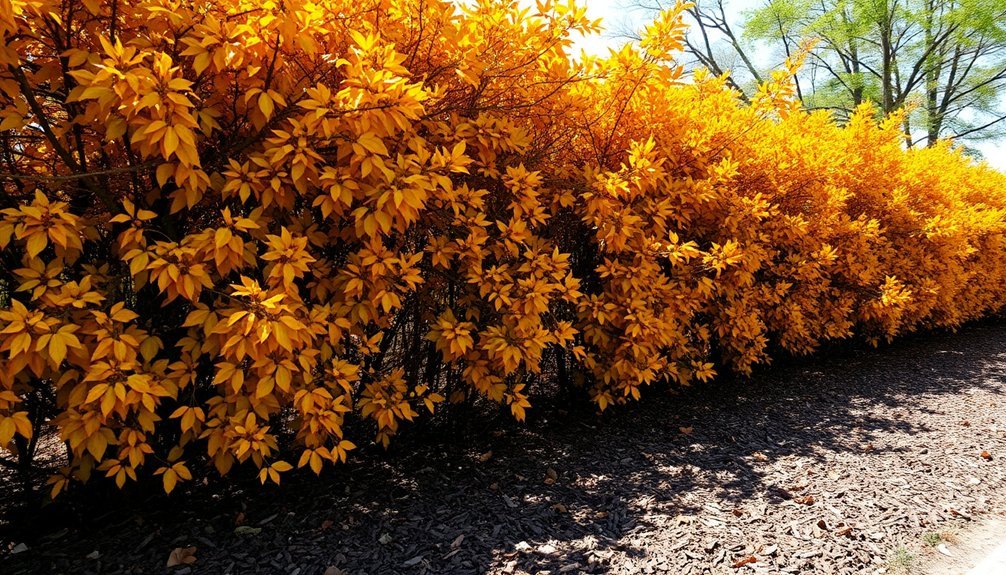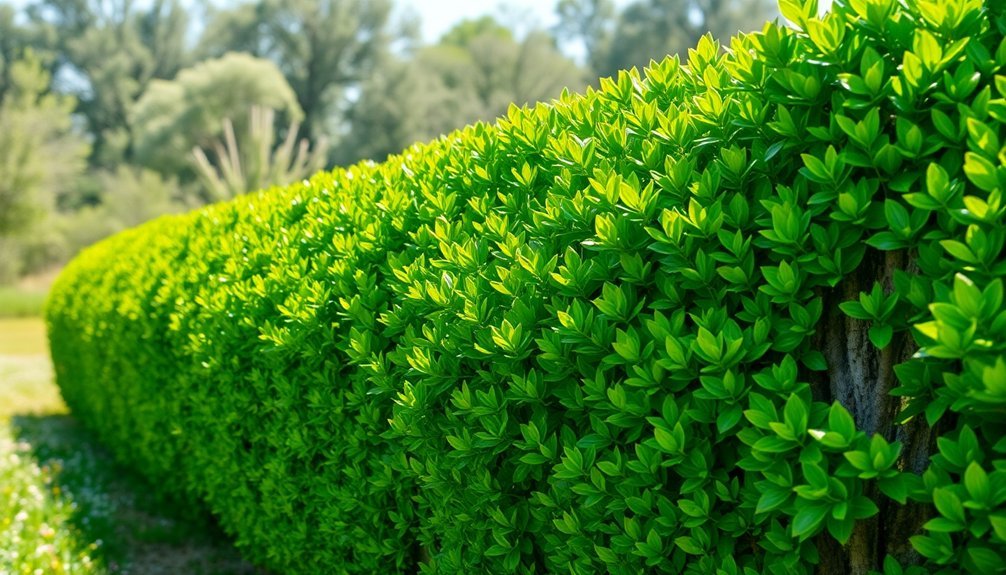Osage orange hedges require seasonal care: spring fertilization and disease inspection, summer deep watering and fungal monitoring, fall mulching and protective barrier installation, and winter structural pruning. You’ll need to maintain a target height of about 5 feet through regular trimming, with first-year plants cut to 6 inches during dormancy to encourage dense branching. Always wear protective gear when working with these thorny plants. The complete maintenance cycle guarantees your living fence remains effective for generations.
The Seasonal Rhythm of Osage Orange Hedge Maintenance

While many landscaping tasks follow a predictable schedule, Osage orange hedges demand attention throughout the year’s changing seasons.
You’ll need to plant seeds in fall or early spring after cold stratification at a depth of 0.25-0.5 inches, spacing them 8-12 inches apart.
During the growing season, protect new sprouts from browsing wildlife and livestock.
These vigorous plants can grow 3-6 feet annually, requiring regular trimming to maintain your target height of about 5 feet.
Every 10-16 years, consider clearcutting to regenerate your hedge with fresh, vigorous growth.
Though this seems drastic, it’s essential for long-term hedge health.
After cutting, you’ll wait several years for the hedge to reach ideal height and width, providing valuable shelter and protection once established.
During the dormant period of the first year after planting, cut your hedge down to 6 inches to promote the dense branching structure that makes these hedges impenetrable to livestock.
Winter Dormancy: Pruning and Structure Management
As winter strips the leaves from your Osage orange hedge, this dormant season offers the perfect opportunity for essential structural management. During dormancy, you’ll want to prune thoroughly to control size and encourage multiple shoots when spring arrives. Winter cutting produces the most vigorous stump sprouts, helping regenerate your living fence. Historically, these trees were prized for their ability to form cattle-deterring hedges before the invention of barbed wire.
| Pruning Task | Benefit |
|---|---|
| Remove overgrowth | Maintains hedge boundaries |
| Cut back to desired height | Encourages dense regrowth |
| Thin overcrowded sections | Improves air circulation |
| Clear base area of weeds | Reduces resource competition |
| Protect new growth | Prevents damage from grazing animals |
Keep the area around your hedge weed-free to maximize spring growth potential. Remember that without proper winter management, your hedge may eventually transform into disconnected single trees, losing its effectiveness as a barrier.
Spring Revival: Fertilization and Growth Monitoring

With winter management complete, your Osage orange hedge stands ready to flourish again as spring’s warmth awakens the dormant plants.
Now’s the time to apply moderate amounts of nitrogen-rich fertilizer to support young tree growth, but don’t overdo it—excess can weaken stems and attract pests.
As soil warms, guarantee your hedge receives full sun and has well-drained soil to prevent root rot. To maximize growth potential, ensure the location offers adequate irrigation since Osage orange thrives in well-drained soil with proper watering.
Monitor regularly for yellow leaves or dead branches, which signal potential health issues. Watch for common threats like rodents and San Jose scale.
Remember that spring is ideal for planting new specimens, with seeds requiring 30-48 hours of cold stratification before germination.
If you prefer organic options, composted manure works well.
Your rejuvenated hedge will soon provide food for squirrels and create an effective thorny barrier.
Summer Care: Drought Management and Pest Control
Summer presents unique challenges for Osage orange hedges, demanding vigilant drought management and pest monitoring despite the species’ natural resilience.
While remarkably hardy, Osage orange hedges require attentive summer care to thrive amid heat and potential pest pressure.
During prolonged dry spells, you’ll need to provide deep watering once weekly, particularly for younger trees that haven’t established extensive root systems.
- Apply a 2-3 inch layer of mulch around the base to retain soil moisture, keeping it several inches away from the trunk to prevent rot.
- Inspect leaves regularly for signs of fungal diseases like Verticillium wilt, which appears as yellowing foliage and branch dieback.
- Prune between June and August to manage shape and improve air circulation, which helps reduce fungal disease susceptibility.
Remember that Osage oranges typically resist most insect pests naturally thanks to their toxic foliage and thorny branches. The female trees may require additional structural support in summer as they develop their large globular fruit, which can reach 4 to 6 inches in diameter.
Fall Preparation: Mulching and Pre-Winter Treatments

The change from summer to fall demands specific preparation for your Osage orange hedge to guarantee it survives winter’s harsh conditions.
Begin by loosening compacted soil through subsoiling and cultivating a 4-foot swath to improve root development.
Apply a 2-3 inch layer of organic mulch like wood chips around your hedge to suppress weeds and conserve moisture. This reduces competition for nutrients during the dormant period. Consider collecting fresh Osage-Orange fruits for stratification through winter rain and snow if you’re planning to expand your hedge next season.
Prune during late fall when plants are entering dormancy, cutting young plants near ground level to encourage bushy growth.
Don’t forget to install protective barriers against deer and livestock damage—these are critical for the first six years until your hedge grows above the browse line.
In high deer pressure areas, consider electric fencing for additional protection.
Rejuvenation Techniques for Aging Hedgerows
Aging Osage orange hedgerows often lose their effectiveness as barriers due to neglect, thinning, and overgrowth, but they can be revitalized through strategic intervention.
Neglected Osage orange hedgerows can regain their barrier function with proper restoration techniques.
You’ll need to assess your hedge’s condition before implementing rejuvenation methods that balance functional needs with ecological benefits.
- Clearcutting and sprout management – Cut the hedge to ground level during dormancy and allow stump sprouts to regenerate, creating dense, thorny new growth while managing competing weeds.
- Selective pruning and infill planting – Remove dead sections while preserving mature trunks, then supplement with new seedlings in gaps to maintain continuity.
- Layered restructuring – Prune at varying heights to create a dense, multi-tiered structure that serves both as an effective barrier and valuable wildlife habitat.
Managing the Hedge Height-to-Width Ratio

Properly maintaining the ideal height-to-width ratio of your Osage orange hedge will determine both its effectiveness as a barrier and its long-term sustainability. For a successful hedge, establish an initial width of about 18 inches before beginning your cutting regimen.
During dormant seasons, prune your hedge to control its aggressive growth. Cut regrowth to 18 inches annually while maintaining a base width of approximately 3 feet that tapers as the hedge grows taller.
You’ll need to trim twice yearly to keep the structure dense and uniform. As you manage height increases, monitor how the width naturally tapers. Be attentive to the presence of sharp thorns present, which are typically 1/2 inch in length and can make maintenance challenging.
The final dimensions—typically 5+ feet tall with a proportional width—should align with your specific needs, whether for livestock protection or windbreak purposes. Wear protective gear when handling these thorny plants.
Addressing Gaps and Ensuring Continuous Barrier Function
Maintaining a continuous, gap-free barrier stands as the primary challenge for Osage orange hedge owners, particularly as these living fences mature.
A thriving Osage orange hedge demands vigilance—its defensive value lies in maintaining impenetrable continuity year after year.
When gaps develop, you’ll need to implement strategic replanting and care to restore functionality.
After clearcutting on your 10-16 year maintenance cycle, follow these key practices:
- Replant at proper density – aim for 240 vigorous stems per 100 meters to guarantee adequate coverage
- Protect new growth – install temporary fencing to prevent livestock and deer damage during the critical 6-year grow-in period
- Implement regular pruning – trim in late winter to encourage bushy growth that fills gaps and maintains the hedge’s protective function
The extreme hardness of Osage-orange wood made it particularly valuable for fence posts and tool handles throughout the nineteenth century.
Regular monitoring for thinning areas will help you address potential weak points before they compromise your living fence’s effectiveness.
Long-Term Sustainability of Your Living Fence

While many traditional fence materials deteriorate within decades, a well-managed Osage orange hedge can thrive for centuries with proper care cycles. Your living fence becomes increasingly self-sustaining over time, developing robust ecological relationships with the surrounding wildlife. The hedge’s sharp thorns make it exceptionally effective as a natural barrier for containing livestock without the need for artificial fencing materials.
| Season | Maintenance Task | Ecological Benefit | Sustainability Check |
|---|---|---|---|
| Spring | Light pruning, inspect for disease | Nesting habitat for birds | Check for invasive spread |
| Summer | Monitor for pests, water if needed | Shade for livestock | Assess biodiversity impact |
| Fall | Harvest fruit, collect seeds | Food source for wildlife | Plan for gap replacements |
| Winter | Heavy structural pruning | Windbreak protection | Evaluate hedge density |
Tools and Safety Practices for Osage Orange Maintenance
Because Osage orange trees are notoriously armed with formidable thorns and irritating sap, specialized tools and strict safety protocols aren’t optional—they’re essential.
When maintaining your living fence, you’ll need sharp pruning saws or heavy-duty equipment with ripping chains for the toughest branches. Consider using a semi chisel chain for Osage orange work, as it requires less frequent sharpening when cutting this exceptionally hard wood.
Your safety preparation should include:
- Complete protective gear – Wear thick gloves, long sleeves, protective glasses, and sturdy clothing to shield yourself from thorns that can easily puncture skin and flatten tires.
- Well-maintained tools – Keep all cutting equipment sharp for clean, efficient cuts that reduce strain and injury risk.
- Seasonal timing – Schedule pruning during favorable weather conditions when the tree’s sap flow is minimal to reduce skin irritation.
Frequently Asked Questions
How Do I Prevent Osage Orange Fruits From Attracting Wildlife?
You’ll need to regularly remove fallen fruits from around your hedge. Consider close planting for dense barriers, and use natural deterrents like the fruits themselves in areas where you want to repel pests.
Can Osage Orange Hedges Be Shaped Into Decorative Forms?
Yes, you can shape Osage orange hedges into decorative forms through regular pruning. Their dense canopies respond well to shaping, and you’ll need to prune twice yearly (June and September) to maintain your desired aesthetic.
What Causes Yellowing Leaves on Established Osage Orange Hedges?
Yellowing leaves on your Osage orange hedge typically result from seasonal change, water stress during drought, soil compaction, disease (especially Verticillium wilt), or poor management practices. It’s natural in fall but concerning other times.
How Fast Do Osage Orange Hedges Grow Annually?
You’ll see rapid growth with Osage orange hedges, typically 3 feet per year, with some growing up to 7 feet annually. They’re impressively fast growers, especially in favorable soil and climate conditions.
Are Osage Orange Hedges Compatible With Other Garden Plantings?
Yes, you’ll find Osage orange hedges work well with other garden plantings. They repel insects, add visual interest, and thrive in various soils. Just manage them properly to prevent them becoming invasive in your garden.
In Summary
You’ll find that maintaining your Osage orange hedge follows a predictable seasonal rhythm that rewards consistent attention. By pruning in winter, fertilizing in spring, managing water in summer, and preparing for dormancy in fall, you’re ensuring a robust living fence. Remember to maintain proper proportions, address gaps promptly, and use appropriate safety gear when working with these thorny barriers. Your diligence will pay off with decades of security and beauty.





Leave a Reply